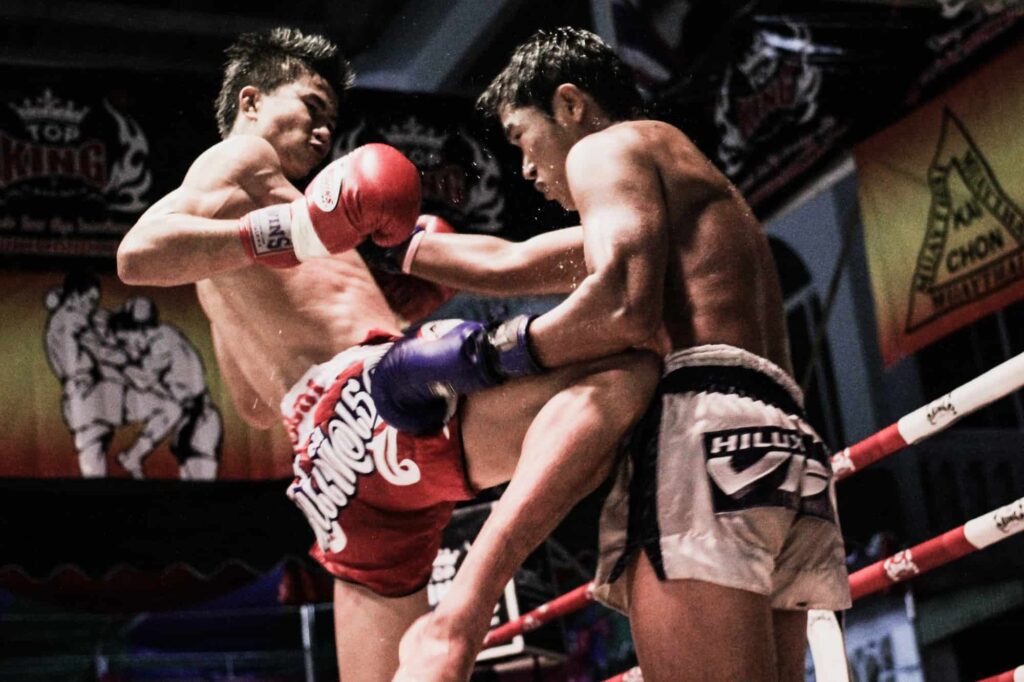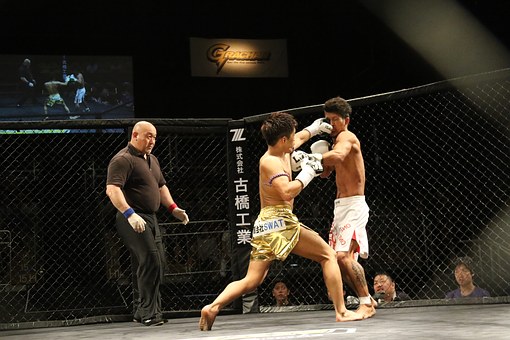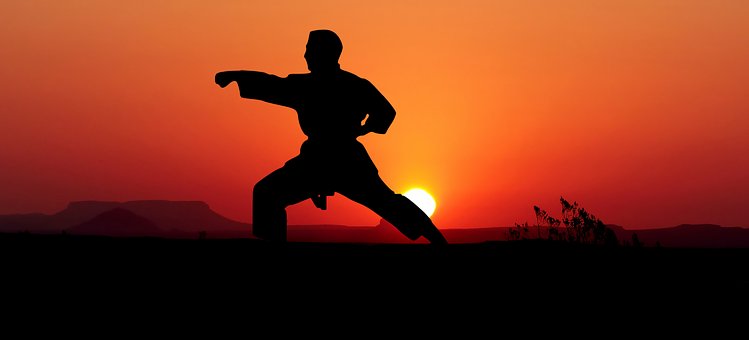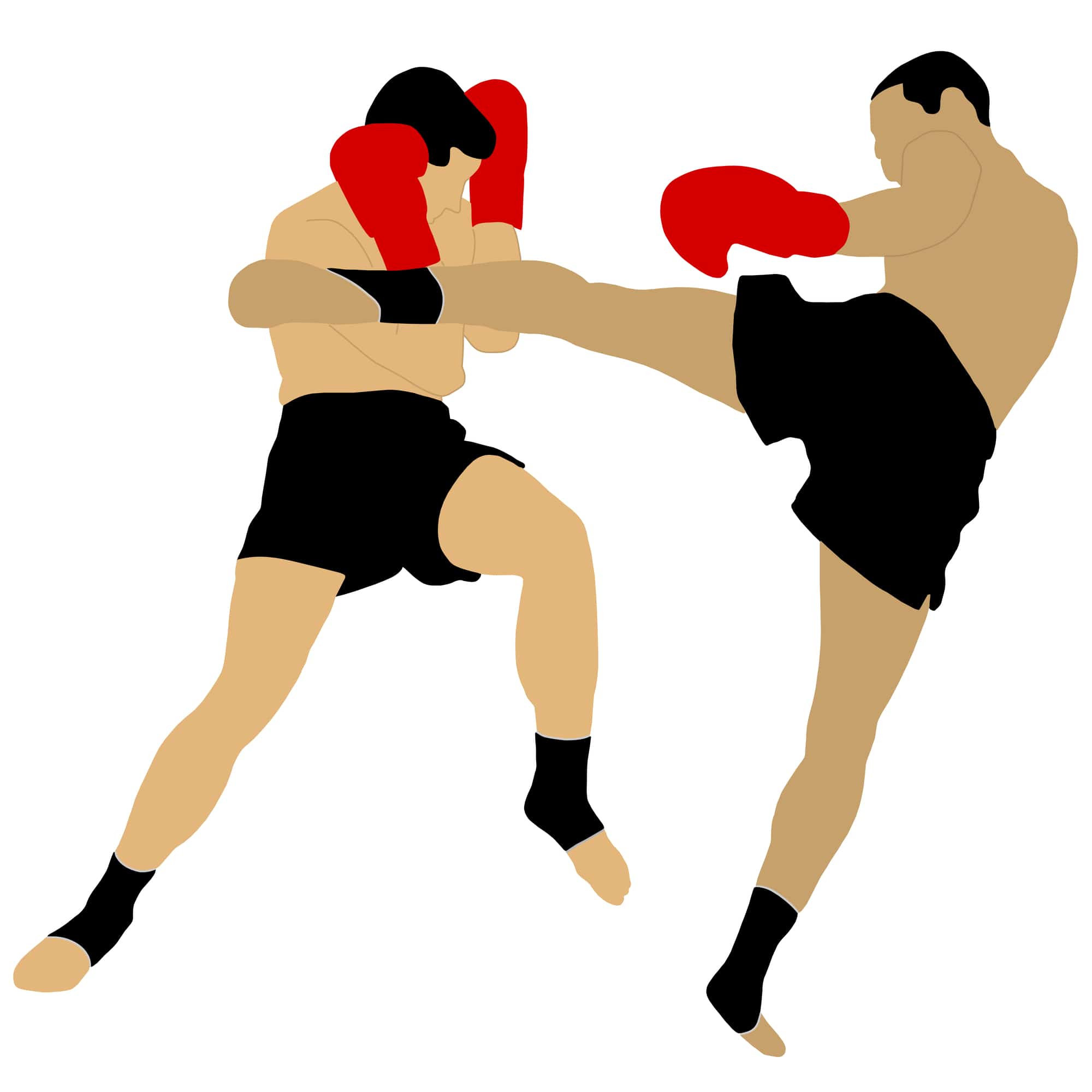To the casual fan or spectator kickboxing and muay thai look pretty much the same.
But if you take a closer look at the two distinct styles there are notable differences between the two martial arts styles.
The main differences in my opinion lie in the tradition and culture of these martial arts that sets them apart, as well as the techniques predominately used under each style and the difference in training.

The main differences between muay thai and kickboxing that are discussed below are summarized as :
- Rule Set – muay thai uses all 8 limbs and has a focus on clinching. Kickboxing rules sets often limit clinching and some rule sets also do not allow elbows to be thrown.
- Traditions – muay thai is rooted in Thai culture and aspects such as Wai Kru, Pra Jiad, the Mongkol as well as Sak Yant are ingrained in muay thai. Kickboxing as a more modern martial art is based on aspects of Karate, muay thai, boxing and has a ‘mixed’ heritage with less focus on culture and tradition.
- Stance – muay thai uses a traditional upright stance with hips square to the opponent. Kickboxing uses a more hybrid stance and can be lower and more grounded with a lot more movement in and out of striking range.
But first it’s important to define the two striking arts which in itself will help to differentiate the two.
So What Exactly is Kickboxing?
Kickboxing is a martial art that predominately utilizes striking techniques. The commonly used strikes are punches kicks and knees.
Elbows and clinching can also be utilized in competition but depending on the particular rule set, they may be not be included.
Kickboxing is a stand-up combat art that utilizes techniques from Western boxing, Karate (especially Kyokushin) and Thai boxing or muay thai.

These striking arts made up the origins of early kickboxing, however there are notable Tae Kwon Do and other striking tournaments that competed freestyle with and without gloves.
However they were not classified as ‘kickboxing’ but still these full contact freestyle matches could be included in the origins of kickboxing.
This post will mainly look at the most widely known styles that were under the ‘kickboxing’ umbrella that are discussed below.
1. Japanese Kickboxing
Japanese kickboxing began in the late 50s when a Japanese karateka named Tatsuo Yamada first established the idea of a new hybrid combat sport that combined Karate and boxing and muay thai.

In fact kickboxing has a very broad and encompassing meaning and history and can be traced back to a variety of different striking arts.
However in terms of modern competition this can be traced to 1950s Japan where rules where set for this new hybrid art of kickboxing.
2. American Kickboxing
Full-contact striking martial arts tournaments were held in the U.S as early as the 1960s. Influenced by Japanese kickboxing, a small number of kickboxing promotions were held in the U.S in the early 1970s as well.
A prominent American kickboxing family is the Roufus family. Duke Roufus is a current UFC coach working with fighters like Tyrone Woodley and Anthony Pettis.
Duke’s older brother Rick Roufus held titles for all the major kickboxing associations worldwide (PKA, IKF, ISKA, FFKA and KICK), and is known for his boxing skills and powerful kicks.
Check out the Lawrence Kenshin video below detailing Rick Roufus versus Kiatsongrit and one of the first large scale audience televised muay thai versus kickboxing match.
This was one of the first to allow leg kicks but restricted clinching to an immediate rest if they clinched up.
The institutional separation of American full-contact karate from kickboxing occurred with the formation of the Professional Karate Association (PKA) in 1974 and of the World Kickboxing Association (WKA) in 1976.
They were the first organised body of martial arts on a global scale to sanction fights, create ranking systems, and institute a development program.
3. Dutch style kickboxing
In the Netherlands kickboxing was introduced in its Japanese form and the Dutch Kickboxing Association was founded in 1976.
Prominent gyms in the Netherlands such as Chakuriki Gym can be sad to have originated from Japanese kickboxing with a heavy kyokushin karate influence.
Many prominent dutch style kickboxers have risen to fame such as Alistair Overeem, Ernesto Hoost, Nieky Holzkien and Andy Hug to name a small few. The YouTube video below shows what Dutch kickboxing is about.
Then What is Muay Thai?
Muay thai is a martial art with a long history of fighting dating back to the ancient fighting arts of South East Asia.
The rich deep history in my opinion is what truly sets muay thai apart from kickboxing.
The tradition of ram muay wai khru that are performed at the start of every muay thai fight; the traditional boxing music that is played throughout the fights, progressively getting faster and more up tempo each round; these are the traditional and cultural aspects that for me make up the biggest difference between muay thai and kickboxing.

In terms of techniques, muay thai of course includes eights limbs, namely hands, legs, knees and elbows.
In comparison, kickboxing, depending on the rule set may not include elbows or clinching, throws, dumps, trips and sweeps.
Clinching and putting your opponent on the ground in particular are a huge part of muay thai.
So Which is Better?
In looking at the difference between muay thai and kickboxing, some of the major differences have been pointed out and they include, the traditions and culture of the arts; the techniques favored and the rule sets which set them apart.
So then which is bettter?
It’s almost impossible to say one is better than the other as both arts have had a long time to develop their distinct styles and also rule sets may be quite limiting and not allow for full use of all your weapons.
Kickboxing and especially Dutch style kickboxing definitely would have the best hands and often muay thai fighters are known for not having the best boxing when it comes to hand exchanges.

However the muay thai clinch which sometimes is not trained a lot in kickboxing is an excellent counter to heavy hands allowing control of heavy punches and the chance to use knees and elbows, which also are not favored in a lot of kickboxing schools, in comparison to muay thai.
Kickboxing is generally seen as more fluid with a lot of movement compared to the straight up style of muay thai with the open hip stance. In terms of MMA a lot of fighters prefer a more closed kickboxing/karate stance i.e Connor Macgregor and this also proves to be very effective.
My best answer to you would be to train a variety and get a lot of ‘looks’ at different styles that will help develop your own style and especially your defense against different styles.
Take the opportunity to explore different styles and enjoy your training and learning martial arts.



